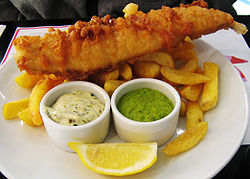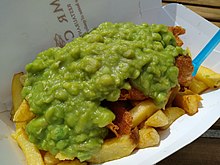Mushy peas
This article needs additional citations for verification. (January 2008) |

Mushy peas are dried marrowfat peas which are first soaked overnight in water with sodium bicarbonate (baking soda), and then rinsed in fresh water, after which the peas are gathered in a saucepan, covered with water, and brought to a boil, and then simmered until the peas are softened and mushy. The mush is seasoned with salt and pepper.[1]
Throughout the British Isles (Northern England and the Midlands in particular) they are a traditional accompaniment to fish and chips. In Northern England they are also commonly served as part of a popular snack called pie and peas (akin to the South Australian pie floater, but with mushy peas instead of a thick pea soup accompanying the meat pie) and are considered to be a part of traditional British cuisine. They are sometimes also packed into a ball, dipped in batter, deep-fried, and served as a pea fritter.[2] Mushy peas can also be bought ready-prepared in tin cans.
Local variants[]

In Yorkshire, Nottinghamshire, Derbyshire and parts of Lincolnshire, mushy peas are often served as a snack on their own. In Nottinghamshire they are traditionally accompanied by mint sauce, and sold at open-air events such as fairs or fêtes. In Derbyshire and Nottinghamshire, mushy peas served with chips is called a 'pea mix'. Mushy peas are also popular in Scotland, served with fish and chips, or as a wetter version with vinegar in a bowl.
A variant (particularly popular around Bolton and Bury of Greater Manchester, and Preston, Lancashire) is parched peas – carlin peas (also known as maple peas or black peas) soaked and then boiled slowly for a long time; these peas are traditionally served with vinegar.
Mushy peas have occasionally been referred to as "Yorkshire caviar".[3]
Artificial colouring[]
Most commercially produced mushy peas contain artificial colourants to make them green—without these the dish would be murky grey.[4] Traditionally the controversial colourant tartrazine (E102) had been used as one of the colourants; however, as recently as 2019, major manufacturers were using a combination of brilliant blue FCF (E133) and riboflavin (E101).[5]
See also[]
| Wikibooks Cookbook has a recipe/module on |
References[]
- ^ Elaine Lemm. Traditional Mushy Peas Recipe. About.com. Retrieved 23 September 2013.
- ^ "Pea fritter". Everything2.com. Retrieved 2 October 2018.
- ^ "48 hours in Bristol / Dining with the locals", The Independent, 26 April 2008
- ^ "The Kitchen Thinker: Food colourings". The Telegraph. 7 February 2011. Retrieved 3 April 2018.
- ^ "Batchelors Original Mushy Peas 300g". Sainsburys. Retrieved 6 January 2020.
- Australian cuisine
- British condiments
- Legume dishes
- English cuisine
- Yorkshire cuisine
- Maltese cuisine